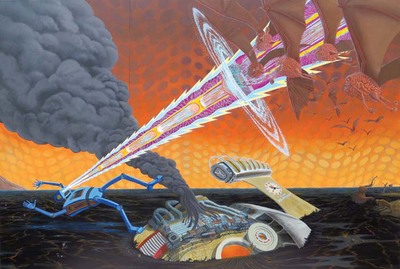NEW/NOW: Angry Robots Liquefied My Brain
Karl Lund, Tar Del Mar and the Flying Brains of the Pleistocene Epoch, 2014, acrylic paint, spray paint, and paint marker on Masonite, 48 x 72″. Collection of the artist.
Karl Lund has taken over the New Britain Museum of American Art’s NEW/NOW exhibit with a sci-fi opus featuring paintings of laser-beaming robots. Inspired as a teen by the museum’s own Robert Lesser Pulp Art Collection, Lund fascinates with 15 works all about pissed-off robots antagonized by seen and unseen enemies.
In the smaller of the two galleries are five of his works from 2007-12, primarily works on paper with the exception of a small acrylic on canvas. His Rivets Shook With Rage is curiously made up of components reminiscent of vintage auto parts, such as a grill for the robot’s mouth and hubcaps for its eyes—à la Metropolis but with parts obviously stuck on like Mr. Potato Head accessories. I’ve Grown Tired of Playing Your Silly Stupid Games, another dose of nostalgia, reveals that the robot’s chest is assembled from bits of childhood games, including Simon Says and Rubik’s Cube.
The next gallery offers seven paintings, a work on paper and a small hanging model dating from 2013-15. Tar Del Mar and the Flying Brains of the Pleistocene Epoch portrays a time machine sinking in a prehistoric tar pit. A stranded robot fends off an evil swarm of flying bat-winged brains, reminiscent of the flying monkeys from The Wizard of Oz. The one sculpture suspended in the gallery is Lund’s model used for rendering these creatures in the painting.
There are several other references to pop culture: an homage to notorious “lowbrow” painter and cartoonist Robert Williams, whose name is painted as the pilot, Robt. Williams, on the side of the sinking Time Bandit—a name derived from Terry Gilliam’s cult classic film of the early 1980s and that of an action/adventure video game too.
Lund’s paintings are loaded with visual details that add elements of interest and mystery. The artist says that he started hiding these things in his paintings—mostly airplanes and time machines—around 2012. They’re there. One just has to look. It’s the kind of work, the more one looks, the more one discovers.

